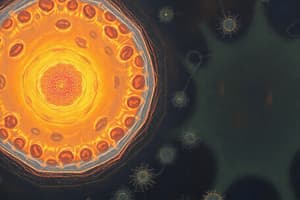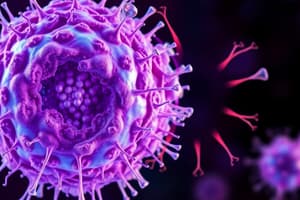Podcast
Questions and Answers
What is the primary function of osmosis in biological systems?
What is the primary function of osmosis in biological systems?
- Transport of ions against their concentration gradient
- Engulfing larger particles into the cell
- Diffusion of nutrients across a membrane
- Movement of water from low to high solute concentration (correct)
Which mechanism is primarily involved in moving substances against their concentration gradient?
Which mechanism is primarily involved in moving substances against their concentration gradient?
- Facilitated diffusion
- Active transport (correct)
- Passive transport
- Osmosis
What type of bulk transport involves the engulfing of solid particles?
What type of bulk transport involves the engulfing of solid particles?
- Phagocytosis (correct)
- Exocytosis
- Pinocytosis
- Endocytosis
In the structure of chromosomes, what is the role of telomeres?
In the structure of chromosomes, what is the role of telomeres?
During which phase of the cell cycle does DNA replication occur?
During which phase of the cell cycle does DNA replication occur?
What is the primary outcome of mitosis in single-celled organisms?
What is the primary outcome of mitosis in single-celled organisms?
What does a checkpoint in the cell cycle ensure?
What does a checkpoint in the cell cycle ensure?
What is the typical chromosome count in human somatic cells?
What is the typical chromosome count in human somatic cells?
What is the size range of prokaryotic cells?
What is the size range of prokaryotic cells?
Which of the following structures is not found in eukaryotic cells?
Which of the following structures is not found in eukaryotic cells?
Where does ATP synthesis primarily occur in eukaryotic cells?
Where does ATP synthesis primarily occur in eukaryotic cells?
Which ribosomes are found in prokaryotic cells?
Which ribosomes are found in prokaryotic cells?
What is the main function of the Golgi Apparatus?
What is the main function of the Golgi Apparatus?
Which component of the cytoskeleton is primarily responsible for cell shape and movement?
Which component of the cytoskeleton is primarily responsible for cell shape and movement?
What is the primary purpose of lysosomes in a cell?
What is the primary purpose of lysosomes in a cell?
Which type of microscope would be best for observing the internal details of a specimen?
Which type of microscope would be best for observing the internal details of a specimen?
What distinguishes prokaryotic cells from eukaryotic cells in terms of DNA structure?
What distinguishes prokaryotic cells from eukaryotic cells in terms of DNA structure?
Which biomolecule is primarily responsible for energy storage in living organisms?
Which biomolecule is primarily responsible for energy storage in living organisms?
Which of the following accurately describes the ribosomes found in prokaryotic cells?
Which of the following accurately describes the ribosomes found in prokaryotic cells?
What is the primary role of flagella in prokaryotic cells?
What is the primary role of flagella in prokaryotic cells?
Which of the following statements about viruses is true?
Which of the following statements about viruses is true?
Which elements are commonly found in biomolecules, as represented by the acronym CHONPS?
Which elements are commonly found in biomolecules, as represented by the acronym CHONPS?
What role do pili play in prokaryotic cells?
What role do pili play in prokaryotic cells?
Which of the following best describes macromolecules?
Which of the following best describes macromolecules?
Flashcards
Osmosis
Osmosis
The movement of water across a semipermeable membrane from a region of low solute concentration to a region of high solute concentration.
Active Transport
Active Transport
Movement of molecules or ions against their concentration gradient, requiring energy (ATP) and carrier proteins.
Endocytosis
Endocytosis
The process of bringing large molecules or particles into a cell.
Exocytosis
Exocytosis
Signup and view all the flashcards
Mitosis
Mitosis
Signup and view all the flashcards
Interphase
Interphase
Signup and view all the flashcards
Cell Cycle Checkpoints
Cell Cycle Checkpoints
Signup and view all the flashcards
Chromosome
Chromosome
Signup and view all the flashcards
What is the nucleoid?
What is the nucleoid?
Signup and view all the flashcards
What are plasmids?
What are plasmids?
Signup and view all the flashcards
What are pili?
What are pili?
Signup and view all the flashcards
How do prokaryotes reproduce?
How do prokaryotes reproduce?
Signup and view all the flashcards
What are prokaryotic cells?
What are prokaryotic cells?
Signup and view all the flashcards
What are eukaryotic cells?
What are eukaryotic cells?
Signup and view all the flashcards
What are viruses?
What are viruses?
Signup and view all the flashcards
What is biochemistry?
What is biochemistry?
Signup and view all the flashcards
What are mitochondria?
What are mitochondria?
Signup and view all the flashcards
What are ribosomes?
What are ribosomes?
Signup and view all the flashcards
What is the endoplasmic reticulum (ER)?
What is the endoplasmic reticulum (ER)?
Signup and view all the flashcards
What is the Golgi apparatus?
What is the Golgi apparatus?
Signup and view all the flashcards
What are lysosomes?
What are lysosomes?
Signup and view all the flashcards
Study Notes
Prokaryotic vs. Eukaryotic Cells
- Prokaryotic cells are 1-10 µm in size.
- Eukaryotic cells are 10-100 µm in size.
- Prokaryotic cells lack a nucleus. DNA is in a nucleoid region.
- Prokaryotic cells have plasmids, small circular DNA that often carry antibiotic resistance genes.
- Eukaryotic cells have DNA inside a membrane-bound nucleus.
- Prokaryotic cells have 70S ribosomes.
- Eukaryotic cells have 70S ribosomes in the mitochondria and chloroplasts, and 80S ribosomes in the cytoplasm.
- Eukaryotic organelles are compartmentalized by membranes.
Organelles and Their Functions
- Nucleus: Double membrane with nuclear pores, contains nucleolus which is the site of rRNA (ribosomal RNA) synthesis. Controls cell activities by regulating transcription.
- Mitochondria: Site of ATP (adenosine triphosphate) synthesis through aerobic respiration. Inner membrane forms cristae, and the matrix has enzymes for the Krebs cycle.
- Ribosomes: Free in cytoplasm (makes proteins for internal use), or attached to rough ER (makes proteins for secretion).
- Rough ER: Processes and folds proteins synthesized by bound ribosomes.
- Smooth ER: Synthesizes lipids, steroids, and detoxifies harmful substances.
- Golgi Apparatus: Modifies, packages, and sorts proteins and lipids into vesicles, and forms lysosomes.
- Lysosomes: Contain hydrolytic enzymes for digestion (autophagy and autolysis).
- Chloroplasts (plant cells): Photosynthesis occurs in the thylakoid membranes and stroma.
- Vacuole (plant cells): Contains cell sap (storage for ions and sugars). Maintains turgor pressure for structural support.
- Cytoskeleton (all cells): Composed of microtubules (shape, transport), microfilaments (movement, cytokinesis), and intermediate filaments (mechanical strength).
Microscopy
- Light Microscopy: Magnification up to x1500; resolution ~200nm. Can observe live specimens.
- Electron Microscopy: Transmission Electron Microscope (TEM) has high resolution, observes internal details. Scanning Electron Microscope (SEM) gives 3D images of surfaces.
Cells are Basic Units of Life
- Cells are the smallest structural and functional units of life.
- All living organisms are made of cells; cells arise from pre-existing cells.
- The cell is the basic unit of structure and function.
Cell Biology and Microscopy
- Microscopy is essential for studying cell structure.
- Light microscopy magnification is up to x1500
- Light microscope resolution is ~200nm
- Stains enhance contrast (e.g., iodine for plant cells).
Plant and Animal Cells
- Visible structures in plant cells: Cell wall, plasma membrane, nucleus, cytoplasm, chloroplasts, large central vacuole.
- Visible structures in animal cells: Plasma membrane, nucleus, cytoplasm.
Studying That Suits You
Use AI to generate personalized quizzes and flashcards to suit your learning preferences.
Related Documents
Description
Explore the differences between prokaryotic and eukaryotic cells through this informative quiz. Test your understanding of their sizes, structures, and organelles. Delve into cell functions and relationship with DNA in both cell types.




